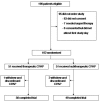Effects of continuous positive airway pressure on quality of life in patients with moderate to severe obstructive sleep apnea: data from a randomized controlled trial
- PMID: 19014075
- PMCID: PMC2579969
- DOI: 10.1093/sleep/31.11.1551
Effects of continuous positive airway pressure on quality of life in patients with moderate to severe obstructive sleep apnea: data from a randomized controlled trial
Abstract
Study objectives: Previous studies have shown that CPAP has a substantial impact on daytime symptoms and quality of life (QOL). It remains unclear which outcome measures best identify real CPAP effects and carry independent information.
Methods: One hundred-two men with moderate-severe obstructive sleep apnea were randomized to either "real" or "sham" CPAP for one month. Outcome measures were subjective sleepiness (Epworth Sleepiness Scale [ESS]) and QOL measures includiig SF-36/SF-12 and Calgary Sleep Apnea Quality of Life Index (SAQLI). The bed partner's QOL and rating of patient's response to CPAP were assessed with the Dublin questionnaire. All data were standardized using effect sizes and expressed as real minus sham to remove the nonspecific effects of placebo.
Results: Real CPAP was superior to sham CPAP in almost all outcome measures. ESS, patient's component from Dublin, and social interactions from SAQLI showed the largest differences in effect sizes between real and sham (1.33, 0.98, and 0.92 respectively). ESS carried the highest predictive power of real CPAP response (P < 0.0001, r2 = 0.21). Question number 5 from Dublin (partner assessed patient's sleep quality) and question 6 from ESS (dozing while talking) were the best single item predictors of real CPAP response.
Conclusions: Real CPAP reduces subjective sleepiness and improves QOL of both patients and bed partners. ESS is the best score; question number 5 from Dublin and question number 6 from ESS are the best single item predictors of real CPAP response. This information should allow the selection of appropriate questions in clinical practice and research protocols.
Figures


References
-
- Young T. The occurrence of sleep-disordered breathing among middle-aged adults. N Engl J Med. 1993;328:1230–5. - PubMed
-
- Young T. Epidemiology of obstructive sleep apnea: a population health perspective. Am J Respir Crit Care Med. 2002;165:1217–39. - PubMed
-
- Lacasse Y. Health-related quality of life in obstructive sleep apnoea. Eur Respir J. 2002;19:499–503. - PubMed
-
- Jenkinson C. Comparison of therapeutic and subtherapeutic nasal continuous positive airway pressure for obstructive sleep apnoea: a randomised prospective parallel trial. Lancet. 1999;353:2100–5. - PubMed
-
- Jenkinson C. Comparison of three measures of quality of life outcome in the evaluation of continuous positive airways pressure therapy for sleep apnoea. J Sleep Res. 1997;6:199–204. - PubMed

